The Best New York Style Pizza Dough and 14 Tips for Success!!
I’ve been making a lot of this NY style pizza dough recipe …. The obsession started a while back, and I’ve finally found a recipe that I love the best! After years of experiments (and I mean years!), I am now using this recipe based on recommendations from the many fine pizza makers at www.pizzamaking.com and the late great Dough Doctor, Tom Lehmann.

Making Pizza Dough at Home
Making NY style pizza dough is definitely somewhat of an art form. There are so many variables that can be changed aside from the ingredients alone. For example, these variables include:
- oven temperature
- temperature of the water used to make the dough
- proofing methods (room temp vs cold rise)
- order of adding the ingredients (yes, this makes a big difference!)
- mixing time
- use of autolyse
- use of poolish (I don’t do this or the one before, although I have in the past)
And then of course, the toppings which can be simple or as complex as you’d like. But don’t worry too much about all of this – my method is easy and straightforward. Plus, you will make better dough than 99% of the pizza chains out there. You will not want take out anymore!
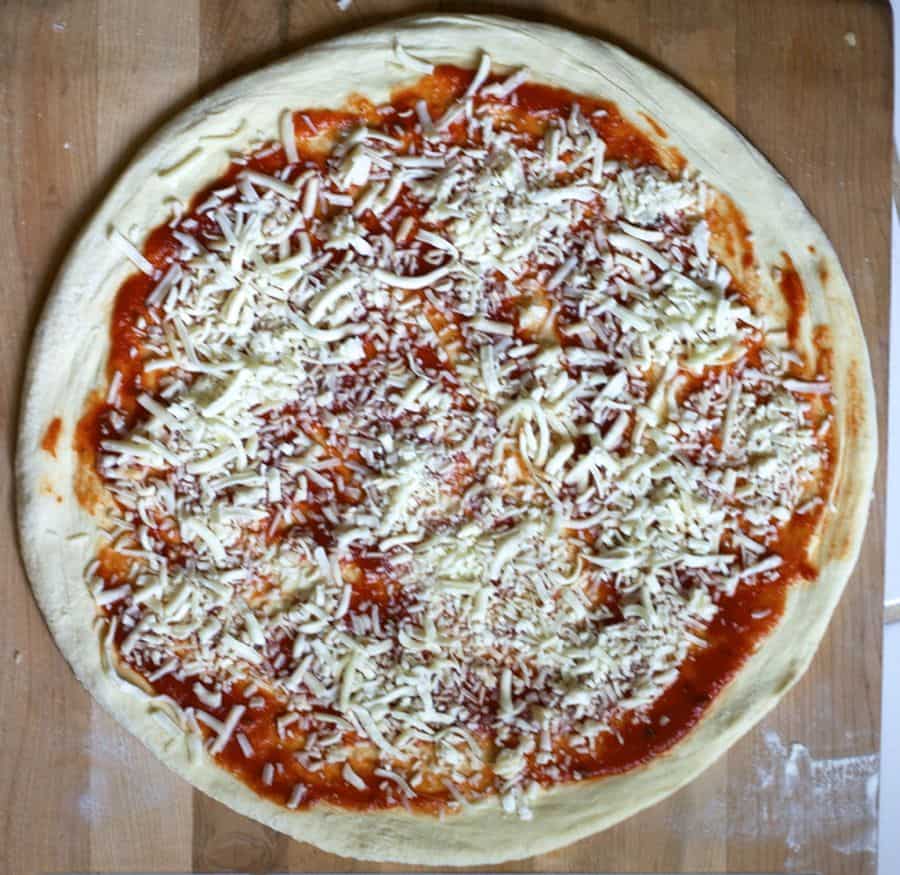
My Favorite Pizza Dough: The Big Secret (How You Proof the Dough)
My all-time favorite dough is NY style dough, which really is classic pizza dough that is stretched out into a thin crust pizza. This type of pizza dough contains water, flour, salt, instant yeast, and olive oil (and sugar especially when baking in a home oven, to help browning).
After it is mixed, it is proofed (left to rise/ferment) in the refrigerator for a minimum of 24 hours and up to 72 hours (it can also be frozen) – this is the big secret. I’ve used the dough up to 5 or 6 days afterwards, so you can essentially prepare dough for the week.
This recipe produces a crisp yet foldable crust that is tender, light, and flavorful and will make enough for four 14-inch pizzas. You can easily double or half the recipe to make 2 or 8 pizzas.

Fourteen Tips for Success
Tip 1: Choosing the flour
Use high-quality flour – I like to use King Arthur’s all purpose or bread flour; higher protein (ie, bread) flours work best. However, I prefer all-purpose flour because I like a lighter, airy crust.
Tip 2: Adding the yeast
Do not add instant dry yeast (IDY) directly to cold or cool water – you may shock the yeast (add the IDY to your flour instead) (please note that IDY differs from active dry yeast, which must be activated by adding it to water).
Tip 3: How much yeast?
Use only enough yeast to “get the job done” – yeast eats the sugar in your flour to produce its leavening effects – I find that if you use too much, your dough will be tasteless (this is just my opinion); however, it is a fact, that too much yeast can make your dough taste bad. Most recipes out there, some of them in well known, published books contain too much yeast!
Tip 4: Cold ferment that pizza dough!
Always use your refrigerator. The best NY style doughs “ferment” or “cure” in the refrigerator for at least 24 hours and up to 48 72 hours. This is called a “cold rise” (vs warm rise on your kitchen counter).
The refrigerator is used to retard (or slow) the dough’s fermentation, allowing that distinctive flavor to come through (ever wonder why some pizza crust tastes different than others, despite the fact that they are both made from just about the same exact ingredients? – this is a big reason why!)
When your dough rises too quickly, the flavor will not develop optimally. Slow rise = MUCH better flavor.
Tip 5: Weigh those ingredients!
Use a scale to weigh the flour instead of using a measuring cup – it is much more accurate and will yield superior results. I’ll admit, I resisted doing this for a loooong time. Just do it. You’ll be glad you did and your dough will be more consistent and much improved.
Tip 6: Add oil last
Mix the oil in as the last step, after the flour has all been incorporated. This is important to allow the flour to hydrate properly.
Tip 7: Flour your dough balls
Before tossing or opening your dough balls, flour them *very* well on each side (if you are a beginner) to ensure they do not stick to your counter or pizza peel. I sometimes use a bit more flour after I begin spreading them.
Tip 8: Keeping those rims a bit puffy
Take care not to “degas” the rim of your pizza as you are spreading your dough! Do NOT ever use a rolling pin! There are many different methods to spread/open your dough ball. I hope to add a few pictures someday of this process.
Tip 9: Baking pizza in a home oven
Ensure that your oven is preheated for a sufficient amount of time (about 1 hour) and bake the pizza within 6 to 8 inches of the top of your oven (ie, your broiler) so that the tops browns sufficiently in conjunction with the bottom of the pizza.
Do not place the stone near the bottom of your oven. I made this mistake for too many years.
After your stone has been preheated sufficiently, the heat from the stone will cook the pizza from the bottom and you can switch the broiler on if you find you need more browning on the top (I now use the broiler to bake my pizzas…more on this sometime in the future).
If you find that your cheese is browning well before your rim attains sufficient color, use partially frozen cheese (ie, place shredded cheese in the freezer while the oven is heating up) and cold sauce or you can drizzle just a bit of olive oil on top of cheese.
Tip 10: Use a pizza stone or steel
Use a pizza stone if you have one. The stone with draw moisture out of the dough and produce a beautifully crisp crust. I use a pizza steel because my stones kept breaking.
Tip 11: Use just the right amount of sauce
Do not use too much pizza sauce – it will make your pizza soggy
Tip 12: Find the right kind of cheese
Do not use low fat cheese to top your pizza or pre-shredded cheese (the former will not melt sufficiently and the latter contains additives that prevent the cheese from sticking together and therefore does not melt very well). The best is low-moisture, whole milk mozzarella.
If you must use pre-shredded cheese, I’ve found that adding the sauce on top of the cheese helps with the melting. Also, do not use too much cheese; apply it sparingly so that you can achieve that mottled NY pizza appearance.
Tip 13: Flour your pizza peel
Use semolina or flour on the bottom of your pizza peel to prevent the pizza dough from sticking but be careful not to overdo it because it will burn.
Tip 14: Learn to launch that pizza
Give the pizza peel a few very small quick jerks to make sure the pizza will easily slide off your pizza peel before attempting to transfer pizza to the oven, and more importantly, rub flour into the peel before placing the dough on top.
Essential Equipment
Please note that as an Amazon affiliate, we earn a small commission if you purchase a product at no additional cost to you.
I adore my baking steel; it’s transformed my home pizzas into restaurant-quality and better. You will love this! A kitchen scale streamlines measurement with remarkable accuracy, while a pizza peel is essential for smoothly sliding pizzas into the oven. And proofing boxes provide an optimal storage for pizza dough fermentation, enhancing flavor, texture, and elasticity.
Please visit our SHOP page for more recommended tools and equipment to make restaurant-style NY-style pizza at home!
How to Stretch the Pizza Dough
A nice video (from The GoodFellas Pizza School of NY), showing how to stretch the dough:

How to Freeze Homemade Pizza Dough
- After mixing dough and dividing into balls, place dough in refrigerator for at least 24 hours.
- Place dough balls on baking sheet lined with plastic wrap or parchment paper, cover loosely with plastic wrap and freeze until firm (~ 2 to 3 hours or up to overnight).
- Wrap frozen dough balls individually in plastic and store in zipper-lock bags for up to 4 weeks.
- When ready to bake, transfer unwrapped dough into the refrigerator for 12 to 24 hours before making pizza.
- Bring dough to room temperature for 20 to 60 minutes before baking (less time for hot kitchen/summer and more time for cool kitchen)
Pizza Dough Calculator
Need more dough? Less dough? Try out our new Pizza Dough Calculator to calculate the weights to get it just right!
Have More Questions?
Please See My NY Pizza FAQ
If you tried this recipe, please leave a 🌟 star rating and let me know how it went in the 📝 comments below! SUBSCRIBE for more recipes.
📖 Recipe

The Best New York Style Pizza Dough
Equipment
- pizza stone or pizza steel for baking
- Standing mixer optional or hand knead
- kitchen scale highly recommended instead of volume measures
Ingredients
Original Recipe for Four 14-Inch Pizzas; want to make more or less? Use the pizza dough calculator
- 6.5 cups (796 g) all purpose flour or bread flour (weighing is most accurate!)
- 2 1/4 cups (493 g) water barely cold water (17.4 oz per 2 1/4 cups)
- 1 teaspoon (3.5 g) instant dry yeast
- 2.5 teaspoons (15.6 g) salt
- 2 teaspoons (7.8 g) sugar
- 1 tablespoon (11.8 g) olive oil
1 Pound of Dough (~454 grams) (use the pizza dough calculator to make more or less dough)
- 2 1/4 cups (274.5 g) all purpose flour or bread flour
- 3/4 cup (170.2 g) water
- 1/2 teaspoon instant dry yeast
- 1 teaspoon salt
- 3/4 teaspoon sugar
- 1 teaspoon olive oil
Instructions
Mixing the Dough
- Place water in mixing bowl.
- In a separate bowl, mix salt and yeast (and sugar if using) into flour
- Combine flour/salt/yeast mixture into water and mix until all the flour has been incorporated.
- After flour has been totally incorporated, add oil and knead for about 4 to 5 minutes (see note)
- Test final dough temperature, which should ideally be between high 70s to low 80s (optional)
Dividing and Rising
- Divide dough into 4 equal pieces (using a digital scale if possible; each ball should weigh 11.5 oz [~326 grams]), shape into a ball, and place in greased, sealed quart-sized container or oiled/greased freezer bag and refrigerate overnight or up to 72 hours (After much experimenting, I have concluded that I like 3 days best but day 2 is good too).
Assembly and Baking
- The following day, remove your dough balls within 1 hour or less of baking and allow the dough to come to room temperature. (the dough will tend to blister more if the dough has not been allowed to come to room temperature however, I often bake coldish dough without problems, just some bubbling)
- In the meantime, place your pizza stone in oven and preheat at 550 degrees (depending on thickness of your stone and your oven’s power) for at least 1 hour
- Open each dough ball using care not to degas, transfer to a pre-floured pizza peel (or on parchment paper), and top with your favorite sauce, cheese, or other toppings.
- Transfer pizza from peel to oven or slide parchment paper onto preheated pizza pan/stone and bake for 4 to 6 minutes each until browned on top and cheese has melted but not burned.
- Enjoy!
Notes
- Use of weight based measurements is highly recommended instead of US Customary. You will need a kitchen scale.
- METRIC amounts DO NOT correspond exactly to the US Customary amounts because, for example, 796 grams equals 6.4 cups (and most can’t measure 0.4 cups or 0.22 cups). Recipe was based on grams.
- Use the Pizza Dough Calculator
- If you want to use the dough the next day, knead a little more (slow speed for about 8 to 10 minutes)
- If you have time to let the dough rest for 3 days, knead for 4 to 5 minutes, low speed or hand knead.
- After mixing dough and dividing into balls, place dough in refrigerator for at least 24 hours.
- Then, place on baking sheet lined with plastic wrap or parchment paper, cover loosely with plastic wrap and freeze until firm (~ 2 to 3 hours or up to overnight).
- Wrap frozen dough balls individually in plastic and store in zipper-lock bags to store for up to 4 weeks (longer may work, but results might vary).
- Before using, transfer unwrapped dough into the refrigerator for 12 to 24 hours before making pizza.
- Bring dough to room temperature for 20 to 60 minutes before baking (less time for hot kitchen/summer and more time for cool kitchen).
- calculate your own using baker’s percentages: 62% hydration, 0.4% yeast, 2% salt, 1.5% oil, and 1% sugar or use my new pizza dough calculator.
Nutrition
Try these other pizzas and this NY pizza sauce:
Buffalo style (one of my absolute favorites)
White with prosciutto
White with spinach and feta
Pizza sauce

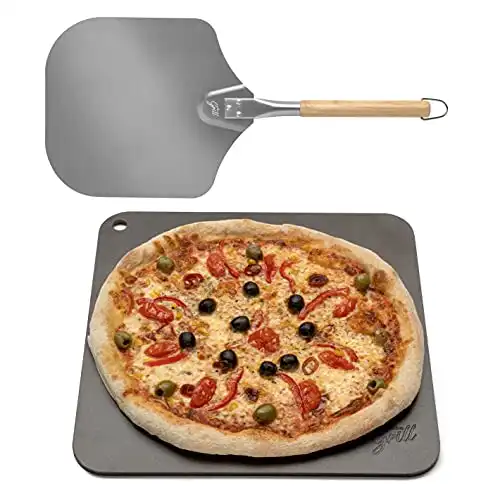
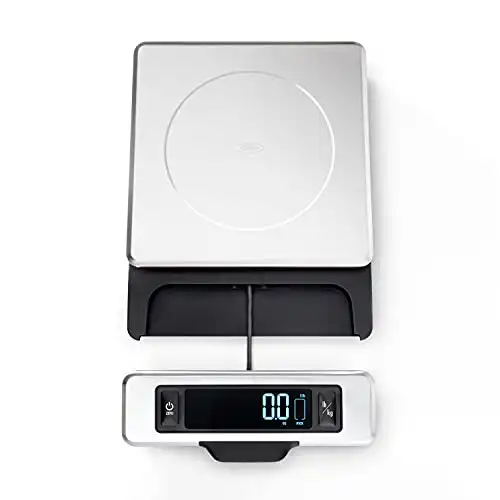
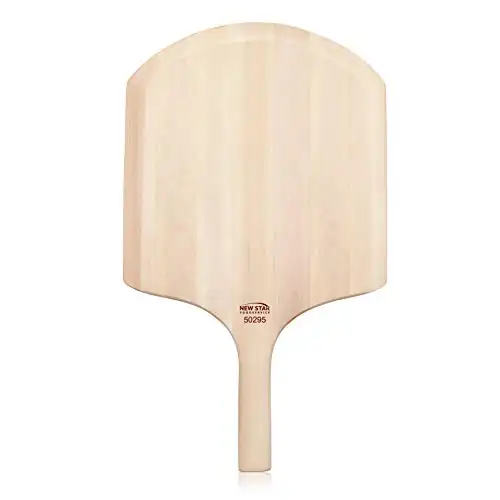
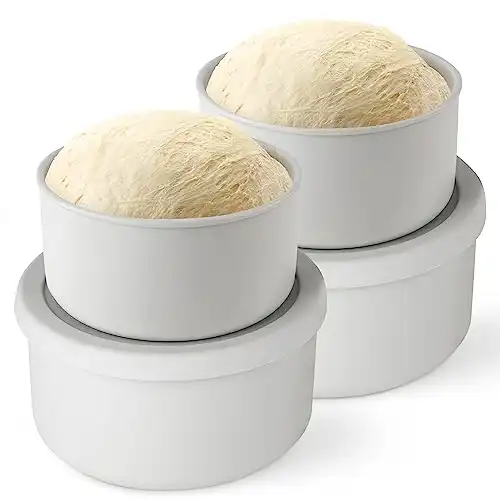
How important is dividing the dough into 4 equal pieces? Would it be alright to divide into 6 or 8 pieces? I’m looking to make more personal size pizzas.
You can divide into smaller pizzas, sure. I’d start with 6 – and if you find they are still too big, try 8 next time.
most recipes tell you to not mix the yeast and the salt in the beginning but rather mix the flour with salt first and then add the water-yeast-sugar mix. which is correct?
you can mix them in with the flour if you are using instant dry yeast, I’ve never had a problem. I should clarify the instructions because you should add flour first, then salt and yeast but not directly on top of each other. In her bread book, Rose Levy Beranbaum adds recommends adding salt to one side of the flour bowl and yeast to the other. If you are more comfortable using the tradition route, add it the way you are describing which is often used for active dry yeast. The brand of active dry yeast that I use can be directly mixed into the flour without “activating” it.
When you say not to add them on top of eachother do you mean mixing them between each new addition… such as: add flour to water, mix, add salt, mix, then add sugar and mix?
yes – that would work just don’t place the two directly in a bowl together and mix and don’t add one on top of another in the flour either. I’ve seen some professional bakers add one to one side of the bowl and the other to the opposite side and then mix
We are gluten intolerant and recently found that we can have flour from Germany because it’s clean!!!! We are making pizza with regular flour for the first time for one of my sweet kiddos tonight! We are soooo excited and don’t have the patience to wait the 3 days to rise in the fridge. Should we find a different recipe this time or will this work well but will just be better with a 3 day rise?
Thank you for all the tips…..soooo excited!!
Yes, you could – this would probably rise a lot slower than you might be used to because of the lower amount of yeast. If you skip the refrigeration period, you would let it rise until doubled on your kitchen counter (room temperature). Then divide and shape into balls and let rest at least 20 to 30 minutes. If you don’t eat right way, place in fridge and take out about an hour beforehand.
Great, thanks so much for the quick reply! Do you think 3-4 hours would be enough?
I wish I could give you an exact hour but I usually don’t do a one day rise – I’d imagine 4 hours at a minimum but you’ll see when it gets nice and puffy (ie doubles) – let us know how it works out. if you can make extra and put it in the fridge you can compare the difference
Great recipe! I want to freeze so I have it on hand when needed. Do I freeze it right away or wait the 48/72 hours first??
I usually just put what I don’t end up using in the freezer, so I’d wait at least 24 hours. I don’t think you have to wait the full 3 days.
I’d pull the dough from the fridge more than an hour before using and be mindful of its temperature afterward. You want it to be at least 75-77 F in the center before opening it, which is higher than typical room temp and takes longer to achieve.
I am using active dry yeast for this recipe. So as always I mixed it into warm water to activate it. Can you please clarify for yeast activation process for both style or all yeasts. Also.i added garlic salt instead of regular salt along with some italian seasoning the non salted type.
Hi Sunny – it’s best to refer to the instructions for your brand of yeast. I haven’t been using a lot of active dry yeast, but if memory serves me correct, there are some brands that do not need to be activated. Here are the instructions from Red Star
Great information! Gonna make a batch and roll out the dough with my pasta roller ans Cut them to make ginormous single NY style slices. Should be delicious
Thanks for explaining everything like you did, I’ve read a lot of dough recipes online but you broke it down so I have a better understanding of why instead of just how.
Hi Marie – I somehow happened across your site (I’m sure it was a google search) but just wanted to say thanks and let you know I love this recipe. I live in Ohio, but spent 4 years working in Manhattan a few years ago and I’ve been sooooo missing NYC pizza!. I’ve only made the dough 4 times so I’m still in learning mode.. but I’m still trying to figure out how to get it done in approx. 6 minutes. I’m using a pizza stone, on the top shelf and letting my oven heat up at 500 degrees for at least 60 minutes… but still needing approx 8 minutes finish. That may just be my oven? I’m planning to experiment with the broiler for 5-10 to heat up the stone on Friday and see how that goes :). For what it’s worth… I’ve tried a couple different cheese’s… and I totally agree on the low-moisture whole milk mozzarella. I’m sure it’s a matter of taste, but I came across a brand on another NYC pizza related site called Polly-O. I can buy it here in Ohio at of all places Wally-Mart,, but it is delicious! Anyway.. Thanks for the great tips and info. Cheers!
Is bread flour the same as wheat flour?
And with protein do you mean gluten?
Thank you for the recipe
Hi Vasilis – You should use a flour with 12 to 13% protein, which refers to the gluten in the flour.
We generally categorize flour as all purpose, bread flour, or cake flour, depending on the strength of the flour (how much gluten is in it). whole wheat is a type of flour that is less processed and has more fiber in it (I use this in combination with bread flour to make bread but not pizza)
I hope this helps?
This really helped, thank you very much!
I never leave comments, but this recipe is great! Thank you for all the tips! I am from New York and am currently living in Texas and I’ve been in need of good pizza. I can never get my crust as thin as I’d like. This recipe gave a good, flavorful dough that I was able to get very thin. I weighed my flour, I used mostly King Arthur AP flour with about 1.5 cups of it bread flour. The dough seemed too wet so I had to add in some more. I let it sit for two days. Usually I cook my pizza With the oven at 450, since it’s august and hot I didn’t want to put the oven all the way up to 550 since 450 works just fine with my other dough recipe. I should have put the oven up to 550 though as the bottom didn’t brown as quickly as the top, but it was still the best pizza I’ve ever made and I will put the oven temp up higher next time. Thank you!
I’ve never mixed the AP and bread flour for a pizza (although I have for bread) – good idea! I’ll have to try it!
Hi, if I just want to make one pizza do I just use 1/4 of all the ingredients including yeast? Also I was thinking of using wholemeal flour but apparently that can make it too light, I’ve read that 2/3 regular flour to 1/3 wholemeal is better, any thoughts on that? Finally I was planning on replacing sugar with a tbs of honey or two if that would work, might throw in some ground ginger for taste? This is the first time I’ve tried this so any tips much appreciated! Cheers!
If you want to use whole grain flour, try to use bread flour with the whole meal. I haven’t tried that combo with pizza but that works well for me with bread. you can definitely easily replace the sugar with honey – I’m not sure about the ginger but I think it would depend on what toppings you are going to use – can’t hurt to try? And yes, you can use 1/4 of the ingredients or you can freeze the rest of the dough.
Thanks for publishing this pizza recipe and the wonderful tips. I checked the amount of water required as given in the list of ingredients. I noticed that 17.4 oz converts into ~515 mL (g) of water and 2 1/4 cup converts into 532 mL (g) of water and both are far from the 493 g given. No doubt the amount of water is critical in that it determines the hardness/softness of dough. Should I just follow the weight measure of 493 g and neglect the volume? Thanks.
George
Hi George, over the years I’ve received many questions about the conversions. It’s a bit confusing, I know. If you look at the flour weight (28 ounces and take 62% of that, it will give you the weight of the needed water, 17.4 ounces).
Using my flour, 28 ounces converts to 796 grams. If you measure by grams, 62% of 796 will give you 493 grams of water. All the other measurements (sugar, salt, oil) are rounded to volumetric measures that are convenient (because it’s not practical to ask someone to measure 1.73 teaspoons, for example).
I know that is confusing but I’d say just stick with either grams or ounces and you will get the target hydration (62%) that is intended. I hope that helps?
Perfcet everytime, Thank you so much for this receipe. Would you recommend me dressing the pizza dough on the stone while hot if I currently do not own a peel?
Glad you like it! If you don’t have a peel you can use a pan or place the pizza on parchment paper on top of a pan and slide it on the hot stone.
Thank you so much.
OK, i found answer with yeast, but still curious about heat in brick pizza oven, shall i burn wood, then let rest it before put pizza in? And when i Cooked 3 or 4 pizzas, the heat from buttom gets much lower,
So I don’t use a brick oven – I use a home oven with some tricks to get a good bake or I use a propane fueled Blackstone oven that mimics a brick oven. One of my best friends has a custom brick outdoor oven and he said it’s important to let the oven sit for 40 minutes after the initial burn so the heat can saturate/penetrate or be evenly distributed to all the bricks. After the initial burn, he cleans the floor of the oven and then closes the door for 40 minutes so the oven temperature can equalize. If this doesn’t work and the floor still isn’t reaching a good enough temp, it might be because there is water getting in the oven and that is causing the floor not to reach high enough temp.
And another question, do you Cook with active dry yeast?
I’ve used both instant dry yeast and active dry yeast – I like the instant dry yeast better for the 3 day rise in refrigerator. If you get a change to check out the FAQ it explains a bit about the reasons
Sorry, i didnt read all 890 coments, so im asking mybe again, if u Cook in log outside brick pizza oven, is there anything secrets? Bcoz i tried 3x, once oven was too Hot and all burn from top but under wasnt realy ready, mostly i have problems getting dought crispy before top is burned, oven is made perfectly from italy oven plans. Shall i close entry while i Cook? And greetings from Latvia.